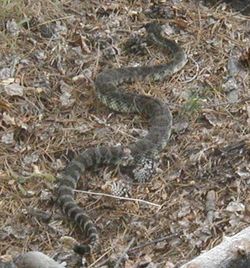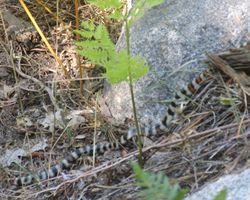Contents |
Snakes
This site was put up to accompany the driving suggestions as part of a series of warnings for those of you new to California. So, we may begin by saying that "Watch out for snakes" may be a bit dramatic. Snakes are really not a danger here in California, since the state has only two types of venemous snakes.
Seasnakes
The first is a venemous sea snake in Southern California. This snake is so rarely encountered that sometimes Southern California is not listed as part of its habitat. The combination of low toxicity of its venom and rarity in the state makes this not worth worrying about.
Rattlesnakes
The only other type of venemous snake is the rattlesnake. These are very common throughout California and are frequently seen. However, snake bites are rare and usually involve handling the snakes and, of course, alcohol.
Rattlesnakes only bite when attacking prey or if they are in imminent danger. Rattlesnakes do not have to inject their venom either, so many human snake bites do not end up being life threatening because not venom is never injected through the bite wounds. Rattlesnakes do not want to bite people and do not want to inject their venom. However, young rattle snakes cannot control their venom and are much more of a danger to people than the adult. Rattlesnakes, in general, would much rather use their fangs and venom to hunt rodents and therefore are generally not considered a large risk to people.
Rattlesnakes will generally warn people by both rattling their tales, making a distinct rattling noise, and by hissing. They will coil into a defensive position, but are able to strike and will if provoked. It is suggested that should you encounter a rattlesnake, leave it alone and it wil leave you alone. Also, it is important to identify rattle snakes by their rattle. It is very common for other snakes, such as gopher snakes, to drage their tales back and forth along dry leaves to mimic rattling noises. This is a tactic to scare you away, but if you know the visual differences and sound differences, it should be easy to distinguish between rattlers and gopher snakes. Again, though, rattlesnakes can loose their rattles so be carfeful!
Rattlesnakes are typically camoflaged. They have colorations that are gray, black and brown to blend in with the surrounding rock and dirt. Rattlesnakes are not colorful. Colorful snakes in California are not venemous!
Finally, Rattlesnakes have lived in California for much longer than we have. They help control rodent populations and provide food for birds and other snakes. Thus, they are an important part of our ecosystem. Please respect these beautiful animals and leave them where they are. Remember, they are more scared of you than you are of them!
Other Snakes
All other snakes in California are non-venemous and are also important part of the California ecosystems. Most feed on rodents, and so provide a necessary service by keeping rodent populations in control.
Many Califoria snakes are quite beautiful. The more common colorful snakes in California are Kingsnakes. One variety of Kingsnakes can be found here in the Santa Clara foothills, and can be described by a alternating pattern of black and white bands. The California Mountain Kingsnake is also very colorul, showing alternating bands of red, black and white.
Garter snakes are small snakes usually found near water such as streams and ponds. They feed on much smaller animals such as small fish. Gopher snakes are found in the low lands and feed on rodents.
You are most likely to encounter rattlesnakes, kingsnakes, gophersnakes and garter snakes. Just remember, snakes are more afraid of you than you are of them! Admire them from a distance and let them be!


